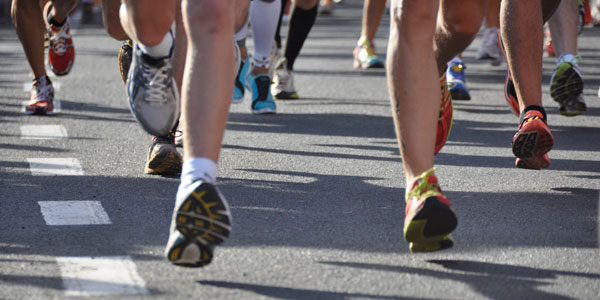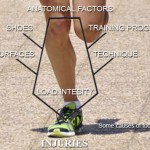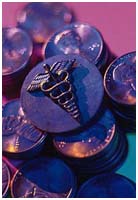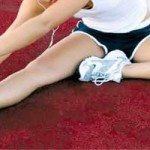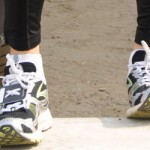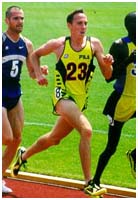On landing, the foot distributes the weight and prepares to propel the leg forward via various mechanisms that contribute to the movement of running. Before this takes place the normal anatomical structure of the foot can go through various deviations which are appropriate to each individual.
Anatomical Factors of Running
Pronation is the most natural of the processes that take place when weight is placed upon the foot however any minor variation away from this can and may cause injuries.
Excessive pronation, and better understood as contributed to via flat-foot (yes, as can be seen by the wet foot placement on the bathroom floor) or over-supination (which is the exact opposite to excessive pronation, so instead of the foot rolling too far inwards the claw foot rolls to far outwards) via pes cavus or claw-foot (naturally high arch).
This is all discussed in a simple manner however when one understands that the foot is quite (to keep it simple) complex and is made up of 26 different bones which are interconnected at about thirty joints and held together by ligaments and joint capsules it is quite incredible that we don’t all have more regular problems with our feet.
Take into consideration that to get the foot to move some 30 tendons, including the muscles of the lower legs (calf) and the muscles of the foot itself are needed to propel you forward, you can better understand why the slight changes in the natural roll of the foot can have a negative impact.
During running, the foot is slightly supinated before you place weight on it. Most often the foot is placed heel first, then the arch takes on the weight (loaded) and begins to flatten allowing for the natural pronation.
From the support phase, moving towards excessive pronation causes increased stress on the supporting structures of the feet as well as added work for the muscles.
This ‘over-pronation’, can be considered to cause overload on the whole of the lower leg due to the inward rotation of the lower leg. This often contributes to overuse injuries and other conditions linked.
The injuries associated with over-pronation include runner’s knee (chondromalacia patellae), shin splints (tibialis posterior syndrome), plantar fasciitis and trochanteric bursitis. It must be noted that anatomical changes may bear no immediate cause to a specific diagnosis.
The high arched foot or claw foot is known to be less flexible and combined with tight calf muscles and ligaments of the sole as well as the reduced weight-bearing due to the insufficient natural pronation taking place leads to or increases the risk of achilles tendonitis, heel pains, ITB (iliotibial band syndrome) and other related problems linked to tight calf muscles such as shinsplints. Also attributed to high arches is the prospect of hammer toe, painful calluses and other attributed problems.
Having read the above, then consider the various factors noted (1st article Causes of Foot Injuries) that affect the load intensity that the foot deals with, then you may be wise in being more careful over the elements you have more control over; what you wear (footwear), how you train (training), your technique and the surfaces you choose to run on.
Do note, your weight can also play a role in this, if you carrying more weight than normal do not try to train as though you were those 5kg lighter, rather train sensibly allowing you to regain your previous weight and performances in a thoughtful manner.
This article is the 2nd article in the series related to Some causes of Foot Injuries
Author: Gavin Doyle






















